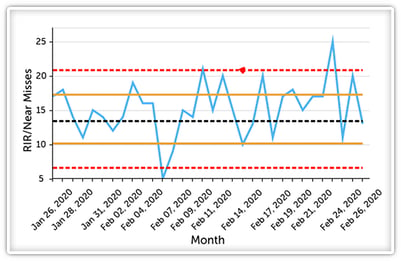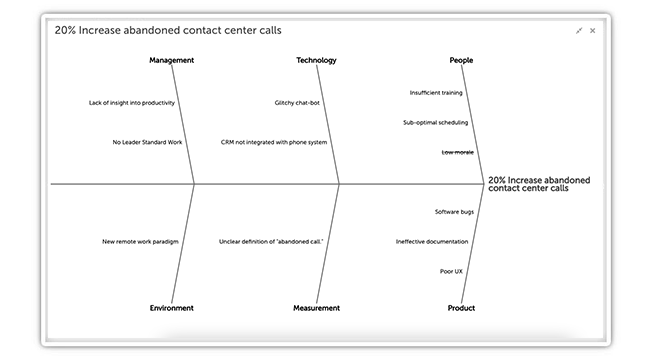 When we talk with people who are interested in implementing a program for continuous quality improvement, one of the biggest challenges they share is the feeling of being overwhelmed. There are countless books and articles about how to improve the quality of processes. You are not alone if you are unsure where to begin. While it is true that you can spend a career learning about tools and techniques for achieving perfect quality, many of those who turn to us are looking for advice on what they can do today to start to achieve positive change.
When we talk with people who are interested in implementing a program for continuous quality improvement, one of the biggest challenges they share is the feeling of being overwhelmed. There are countless books and articles about how to improve the quality of processes. You are not alone if you are unsure where to begin. While it is true that you can spend a career learning about tools and techniques for achieving perfect quality, many of those who turn to us are looking for advice on what they can do today to start to achieve positive change.
Whether your goal is to produce quality products for customers or improve quality outputs for internal processes, the following steps can make a big difference.
Implement Standard Work
It is not possible to introduce thoughtful improvement if a process or task is not being performed consistently. Therefore, the first step to quality improvement is introducing Standard Work. Standard Work is a document that states the current best practice for performing any activity or task. It is developed by the process operators. It must be up to date and available where the work is done. It often includes diagrams, photographs, or other artifacts that clarify the process. The Standard is the baseline upon which you can improve.
Try the 5 Whys
It is critical to remember that lasting quality improvement comes from addressing the root causes of problems rather than applying Band-aids or workarounds. The 5 Whys is a simple yet powerful method for doing just that. Leaders and process operators state the problem and ask Why until the root cause is revealed. The number of times you have to ask why will vary based on the complexity of the process and the problem, but usually, about five will get you there.
Use a Structured Quality Improvement Method
Organizations use several structured improvements cycles to implement quality improvement. For example, DMAIC (Define, Measure, Analyze, Improve, Control) is popular with organizations that have implemented Six Sigma and are interested in statistical control. However, many of our customers prefer a more straightforward approach called PDSA.
Step 1 - Plan: The first objective is to define what you want to improve and state your quality goals. At this stage, all stakeholders, process operators, subject matter experts, and others involved in the improvement are identified. Next, the team will document the current process and develop an improvement plan. In addition, you will identify the metrics by which success will be measured and gather baseline data.
Step 2 - Do: Once there is consensus about the plan, the team will implement the proposed change. While the Standard Work won’t be updated until later, everyone must perform the process according to the new plan while data is gathered and success is evaluated.
Step 3 - Study: With the new operating procedure in place, you can analyze the results to determine if quality has been improved. At this point, you’ll also look for unintended consequences and consider the input of process operators.
Step 4 - Adjust: If the change has had the desired impact, you can update the Standard Work and keep the new procedure in place until the next improvement cycle begins. Otherwise, the team can reconsider the plan and explore different potential solutions.
Play Catchball
During the Plan phase of PDSA, the practice of Catchball can be a helpful way to generate ideas and gather feedback from the team. The technique starts when someone (usually a manager, but not always) offers an idea for process improvement or a statement of the problem. It is then “passed” back and forth between leaders, front-line workers, internal customers, and others interested in the outputs from the process. Moving the idea around without a strict hierarchy of decision-makers increases employee engagement and improves the original notion.
Leverage Process Control Charts

Control charts are a handy tool during the Study phase of PDSA. They help you identify trends and variance as you examine your quality results. Data is plotted in a time-ordered sequence on a chart that has a midline for the average results and upper and lower control limits. You should expect to see some variance within limits, but results above or below the control lines generally require attention. They may represent unexpected variations in the process. The charts help you identify trends that may indicate a change has resulted in improvement or something going wrong.
Practice Gemba Walks
Gemba Walks are a practice borrowed from the Lean business methodology. During a Gemba Walk, the leader visits the workspace to ask questions, observe activities, and, most importantly, show respect for employees. Change is not implemented during a Gemba Walk, nor is the walk used for employee performance evaluation. Instead, it serves as a potential starting point for a PDSA cycle and an opportunity for process operators to share their thoughts on each process element.
Create a Value Stream Map
A common reason for quality problems is that, over time, processes become unnecessarily complex, introducing increasing opportunities for error. Value stream mapping is a useful way of identifying activities and materials that don’t add value to the customer. Eliminating this waste allows you to streamline your process and focus on achieving excellent quality for the elements you do need.
Leverage Fishbone Diagrams
The 5 Whys technique is helpful for many issues, more complex problems may require a more structured approach to problem-solving. Fishbone diagrams are an approach that breaks down potential root causes into common categories and encourages the team to explore each one. While the categories can vary based on the nature of your organization and its products, the most common categories are materials, environment, equipment, management, people, and measurement. The diagram looks something like the skeleton of a fish, with the problem as the head and each of the categories as a bone.

Hold a Rapid Improvement Event
In general, we think that daily, incremental improvements are the surest path to success. Still, sometimes the quality of process results is such that more urgent and immediate action is needed. In that case, a rapid improvement event can lead to a quick solution. During an improvement event, a team including the process operators, subject matter experts, leaders, and other stakeholders puts aside their regular duties for a three to five-day focused quality improvement effort. This allows for an accelerated PDSA cycle. Leadership is crucial during an event of this sort, so selecting a skilled facilitator to guide the effort is essential.
Implement Quality Improvement Software
While improvement events are great, operationally excellent organizations know that quality improvement is a long-term ever-lasting effort. That’s why they frequently invest in software tools to structure and organize their improvement efforts. Quality improvement software allows employees to easily suggest opportunities for improvement, which are routed to managers for review. Once an improvement project begins, the solution provides the necessary workflow for making sure forward progress is maintained. It also measures the impact of change against quality goals. With a documented knowledge repository, the team gets smarter with every improvement.

It is unlikely that you will improve the quality of your processes overnight, but these techniques can help you get started. You don’t need to come up with the perfect solution all at once. Incremental improvement is the key to achieving your most pressing quality improvement goals.



Add a Comment